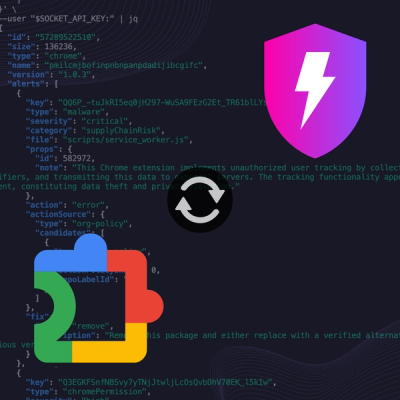
Product
Socket Now Protects the Chrome Extension Ecosystem
Socket is launching experimental protection for Chrome extensions, scanning for malware and risky permissions to prevent silent supply chain attacks.
Python interface to the Google WebRTC Voice Activity Detector (VAD) [released with binary wheels!]
.. image:: https://img.shields.io/pypi/v/webrtcvad-wheels.svg :target: https://pypi.python.org/pypi/webrtcvad-wheels/ :alt: PyPI Version .. image:: https://img.shields.io/pypi/pyversions/webrtcvad-wheels.svg :target: https://pypi.python.org/pypi/webrtcvad-wheels/ :alt: Supported Python Versions .. image:: https://img.shields.io/pypi/wheel/webrtcvad-wheels.svg :target: https://pypi.python.org/pypi/webrtcvad-wheels/ :alt: Wheel Support .. image:: https://img.shields.io/pypi/dm/webrtcvad-wheels.svg?logo=python :target: https://pypi.python.org/pypi/webrtcvad-wheels/ :alt: Downloads per Month .. image:: https://github.com/daanzu/py-webrtcvad-wheels/actions/workflows/build.yml/badge.svg :target: https://github.com/daanzu/py-webrtcvad-wheels/actions/workflows/build.yml :alt: Build Status .. image:: https://img.shields.io/badge/donate-PayPal-green.svg :target: https://paypal.me/daanzu :alt: Donate via PayPal .. image:: https://img.shields.io/badge/sponsor-GitHub-pink.svg :target: https://github.com/sponsors/daanzu :alt: Sponsor on GitHub
This is a python interface to the WebRTC Voice Activity Detector (VAD).
It is forked from
wiseman/py-webrtcvad <https://github.com/wiseman/py-webrtcvad>_ to
provide updated releases with binary wheels for Windows, macOS, and
Linux. Also includes additional fixes and improvements.
A VAD <https://en.wikipedia.org/wiki/Voice_activity_detection>_
classifies a piece of audio data as being voiced or unvoiced. It can
be useful for telephony and speech recognition.
The VAD that Google developed for the WebRTC <https://webrtc.org/>_
project is reportedly one of the best available, being fast, modern
and free.
Install the webrtcvad module::
pip install webrtcvad-wheels
Create a Vad object::
import webrtcvad vad = webrtcvad.Vad()
Optionally, set its aggressiveness mode, which is an integer
between 0 and 3 (inclusive). 0 is the least aggressive about filtering out
non-speech, 3 is the most aggressive. (You can also set the mode
when you create the VAD, e.g. vad = webrtcvad.Vad(3); the default is 0)::
vad.set_mode(1)
Give it a short segment ("frame") of audio. The WebRTC VAD only accepts 16-bit mono PCM audio, sampled at 8000, 16000, 32000 or 48000 Hz. A frame must be either 10, 20, or 30 ms in duration::
sample_rate = 16000 frame_duration = 10 # ms frame = b'\x00\x00' * int(sample_rate * frame_duration / 1000) print 'Contains speech: %s' % (vad.is_speech(frame, sample_rate)
See example.py <https://github.com/daanzu/py-webrtcvad-wheels/blob/master/example.py>_ for
a more detailed example that will process a .wav file, find the voiced
segments, and write each one as a separate .wav.
To run unit tests::
pip install -e ".[dev]"
python setup.py test
2.0.14
hack3ric <https://github.com/hack3ric>_!zhangwenlong8911 <https://github.com/zhangwenlong8911>_!2.0.13
Vad objects. Thanks, manipopopo <https://github.com/manipopopo>_!2.0.12
pkg_resources usage for Python 3.12+.2.0.11.post1
2.0.11
2.0.10.post2
2.0.10.post1
FORK
2.0.10
bond005 <https://github.com/bond005>_!2.0.9
2.0.8
xiongyihui <https://github.com/xiongyihui>_!FAQs
Python interface to the Google WebRTC Voice Activity Detector (VAD) [released with binary wheels!]
We found that webrtcvad-wheels demonstrated a healthy version release cadence and project activity because the last version was released less than a year ago. It has 1 open source maintainer collaborating on the project.
Did you know?

Socket for GitHub automatically highlights issues in each pull request and monitors the health of all your open source dependencies. Discover the contents of your packages and block harmful activity before you install or update your dependencies.

Product
Socket is launching experimental protection for Chrome extensions, scanning for malware and risky permissions to prevent silent supply chain attacks.

Product
Add secure dependency scanning to Claude Desktop with Socket MCP, a one-click extension that keeps your coding conversations safe from malicious packages.

Product
Socket now supports Scala and Kotlin, bringing AI-powered threat detection to JVM projects with easy manifest generation and fast, accurate scans.